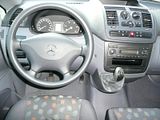





Hertz had very thoughtfully left the Vito in an area of their parking garage all by itself. Nevertheless, even without any immediate reference point, it was immediately apparent just how large this vehicle is. Most of that impression comes from the height, as it is actually neither any wider or longer than some of the other larger vehicles that grace European roads, and it did not prove as difficult as I feared it was going to be, to get it around the rather awkward turns out of the Zurich airport car park, or to get it back in again. There’s no getting away from the fact that it is tall. though. There is a really noticeable climb up, to get in. There is a cut out area you can use as a step, but I actually slipped on this the second time I try to ascend, and thenceforth decided to use the steering wheel as a fixed item to grab, to help lever me up. Once installed, you are in no doubt that you are sitting up high, which gives you a very commanding outlook on other traffic.
The seat alongside the driver’s, is a bench, intended for two, though the person sat in the middle would need to have very short legs (yes, shorter than mine!), if they were to clear the centre of the dashboard, where the gearlever is mounted. Although there is some rearward adjustment of the seat, they cannot go back very far, as there are still the remnants of the bulkhead that would feature in the van. Behind this, there are two rows of three seats, accessed by the sole, near-side mounted sliding door. The middle row of seats tip well forward to allow for easy access to the rear-most seats, and there is ample legroom, and positively acres of headroom available for all the occupants. There’s not a massive boot area, but it is very deep, so you could pile a lot of luggage in, if it were the right shape. There’s also plenty of stowage space under the middle and rear row of seats, and some positively cavernous stowage bins down the side where there is no door. Hertz had got a boxed set of tyre chains in here, and they fitted easily. The door bin on the driver’s door had the warning triangle buried down at the bottom, which was so deep, I could not reach it from the driver’s seat. There’s also a reasonable sized glove box, and a lipped area on top of the dash, as well as small and deep cubby under the stereo. So, little down that there’s lots and lots of space in the Vito.
However, it can only hope to pass muster if it is reasonable to drive. You start off with a typical Mercedes “key”, a piece of plastic that is shaped rather like the item which opens the gas and electricity meters at home, which goes in a conventional ignition key slot. As this is a diesel, turn it on, wait a couple of seconds, and fire the engine. Oh! I’ve not heard a sound like that from even the roughest diesel cars for ages. At start up, and idle, and low revs, this really does sound like a diesel from about 10 to 15 years ago. Slot the positive feeling, dash-mounted gearlever into first, pull the release lever on the lower left side of the dash to let the foot-operated handbrake off, and set off. Almost instantly, you feel the need for second, then third, then fourth and even fifth, before getting to more than about 50 km/h. This is a reasonably torquey engine, but it is also quite low geared, so you feel that the lowest gears are just for moving off, or for climbing steep inclined when heavily laden. As there was only me on board, and I did not head into the mountains, they were not used much. There is a sixth gear, and once this is engaged, at a steady 100 km/h, on the autobahn, the Vito is actually quite refined and decently quiet. But lift off a bit and then accelerate, and the diesel sound is there again. After driving much more refined diesels of the modern era, this one would take some getting used to.
You don’t really buy an MPV expecting it to be fun to drive. Still less would you expect a van-derived 9 passenger car to be so. And it is not. At least not in the traditional sense of the word. But change your expectations, and actually, it was OK. Sure, the noise from the engine was a trifle wearing, but the gearchange is good, and the steering is light and positive, the brakes are good, and the Vito rides quite comfortably. It’s certainly not the last word in handling prowess, but then it is not intended to be. It seemed to go around the sweeping corners of the autobahn intersections at a decent pace, without leaving me feeling scared or having to slow and baulk other traffic, and that was about the limit of what I was able to test in the day that I had the Vito. One other benefit, is that as you sit up high, you can sense and see far better what is going on around you. There are two enormous door mirrors that give an outstanding view. The interior mirror was very small, and not much use, as even with all the headrests in their lowest position, they seemed to fill the view quite well.
There are other reminders that this is a Mercedes. The seats are clearly designed for the larger framed individual. They were quite firm, and although I was able to adjust them fore and aft, the back-rest and the height, so I had a comfortable driving position, I could feel a few aches in the thighs after a couple of hours behind the wheel. The whole ambience of the interior says “Mercedes” to you. Probably Mercedes of about 20 years ago, though that is no bad thing, as that is the era when Mercedes felt like they were hewn from solid granite. The interior of this one felt like it would last well. There is a full air-conditioning system, and a decent stereo system, but otherwise, there are no real luxuries, but then if the cost is to be kept down, that is the point.
The Vito does not have this market to itself. The VW Bus has been a long-standing, and cheaper (and slightly smaller) competitor. Earlier in 2007, the latest Citroen/Peugeot/Fiat trio of passenger vans made it to the market. They certainly look more modern, but whether they are as solid and sensible and tough as the Vito is not something I can (yet, at least!) assess. I started the test wondering whether I should go ahead, or whether to go back and ask for something more conventional, but 24 hours later, I could start to see the attractions of the Vito. Maybe there is even a place for the van-derived people carrier when it is based off as sound a base as Mercedes has got.





















